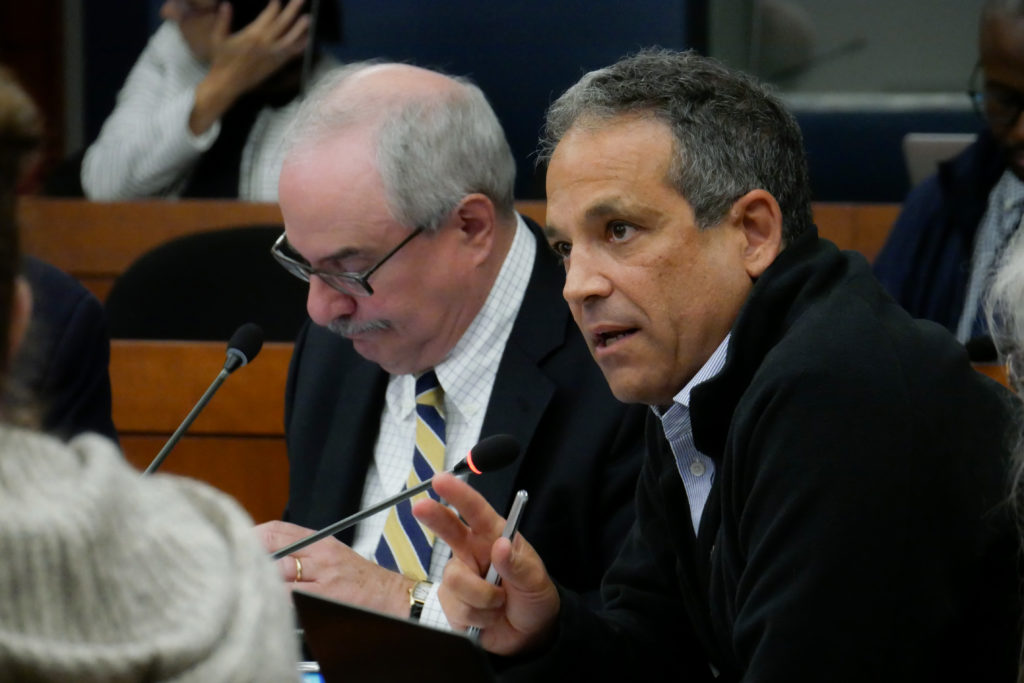Officials’ planned enrollment changes could impact GW’s academic profile and reduce diversity while decreasing net revenue, according to a presentation from the Office of the Provost.
Former Provost Forrest Maltzman presented six enrollment models to the Faculty Senate’s Educational Policy and Technology Committee Oct. 24 that illustrate the effects of cutting enrollment by roughly 20 percent and upping the share of undergraduate STEM majors to 30 percent, according to documents obtained by The Hatchet. The models show a trade-off between diversity, revenue and the academic strength of incoming classes.
“There is no model that meets all enrollment objectives,” the presentation states. “Need to decide what is the right compromise to make between enhancing academic profile, net tuition goals, diversity goals (including Pell and gender) and school balance.”
Maltzman said University President Thomas LeBlanc plans to give a presentation to the Faculty Senate at its December meeting about enrollment modeling but declined to answer further questions, adding that he wanted to be “fair” to the new provost, Brian Blake, and allow him to speak about the matter.
University spokeswoman Crystal Nosal did not return a request to comment on the models.
All six models predict revenue losses between $8 million and $36.2 million per year. LeBlanc said in October that the enrollment reduction will cost about $16 million per year for the next four years.

Three of the scenarios first prioritize boosting the STEM enrollment ratio but then consider trade-offs between net tuition revenue and GW’s academic quality, using a seven-point scale where a score closer to one indicates stronger academic performance.
The presentation’s first model reveals that increasing the STEM ratio of incoming classes to 45 percent while enrolling the strongest applicants by academic performance could cost the University about $33.5 million per year in aggregate net tuition, reduce the proportion of male students from 37 percent to 31 percent in the incoming class and will be accompanied by a nearly $65 million grant from GW’s endowment.
“STEM can be boosted with current applicant pool, but if you want to exclude weak STEM will see significant reduction in proportion of male students,” the presentation states.

Maximizing tuition revenues while prioritizing the STEM ratio would cost the least of the estimated models – about $5.3 million in aggregate net tuition per year – but would negatively affect GW’s academic quality the most compared to the other models, according to the documents. Academic quality would rise 0.8 points relative to the University’s baseline goal of 4.46 to hit an average of 5.2 out of 7 for the incoming class, the slides state.
The presentation states that the school can meet an increased STEM target and minimize losses to the school’s academic profile at a loss of about $13 million in net tuition. But those goals would necessitate a decrease in the proportion of students of color – excluding Asian students – of 7.5 percentage points from the University’s baseline goal of 23 percent, amounting to a final figure of 15.3 percent of the incoming class of 2,110 students.
The other three models prioritize admission of affinity students – athletes and early decision applicants – followed by boosting either the academic profile, net tuition revenues or the proportion of Pell Grant recipients.

Those scenarios could cause an annual loss in revenue between about $13.4 million and about $29.3 million relative to GW’s baseline goal while also potentially driving a loss in underrepresented minorities of 2 percent to 7 percent relative to the baseline, according to the documents. The presentation does not include any scenario that grows the proportion of students of color excluding Asian students while meeting the enrollment cut and STEM goal.
Faculty have previously raised concerns about the enrollment cut’s effect on diversity, but Board of Trustees Chair Grace Speights said the change will “not impact diversity” at a Faculty Senate meeting in October.
The six models assume the applicant pool, “admissible” applicants and financial aid awards are identical to prior years. The models maintain a fixed goal of matriculating 2,100 students by adjusting the number of admitted students to meet changing yield rates resulting from changes in the tuition discount – the average discount students receive on the sticker price of tuition – in each model.
Jason Zara, the chair of the education policy committee, did not return a request for comment. Five members of the committee declined to comment.
Harald Griesshammer, a member of the committee and an associate professor of physics, said LeBlanc appears to prefer the scenario that prioritizes increasing the proportion of STEM majors followed by prioritizing academic quality and net tuition revenue, which could lead to revenue loss of about $15.6 million per year and result in a 7.5 percent drop in underrepresented students of color, according to the presentation.
The revenue loss figure matches the figure LeBlanc has given at public meetings about the enrollment changes.
He added that he has heard trustees react positively to the model that maximizes STEM students followed by tuition revenues, which could cause a net revenue loss of just $8 million per year but decrease the academic quality of the incoming class, according to the presentation.
Griesshammer said he has concerns about the potential loss in revenue and diversity in the student body.
“There is going to be a budget impact,” Griesshammer said. “That’s already scary enough. But what I was actually more scared about is the impact this has on the student population – that by all indicators, diversity just takes a huge hit.”
Jared Gans contributed reporting.




